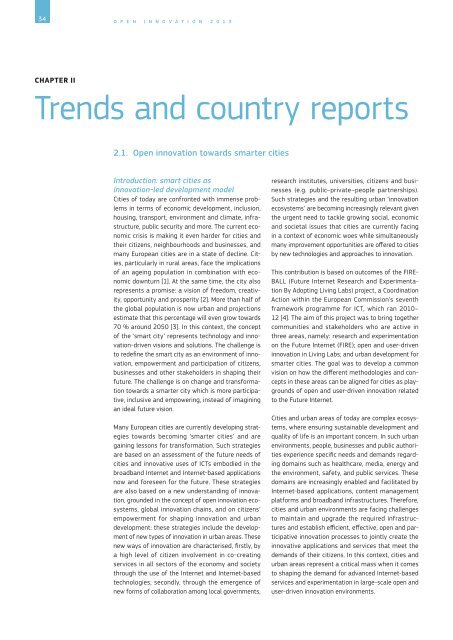Open Innovation 2.0 Yearbook 2013 - European Commission - Europa
Open Innovation 2.0 Yearbook 2013 - European Commission - Europa
Open Innovation 2.0 Yearbook 2013 - European Commission - Europa
You also want an ePaper? Increase the reach of your titles
YUMPU automatically turns print PDFs into web optimized ePapers that Google loves.
34 O P E N I N N O V A T I O N 2 0 1 3<br />
CHAPTER II<br />
Trends and country reports<br />
2.1. <strong>Open</strong> innovation towards smarter cities<br />
Introduction: smart cities as<br />
innovation-led development model<br />
Cities of today are confronted with immense problems<br />
in terms of economic development, inclusion,<br />
housing, transport, environment and climate, infrastructure,<br />
public security and more. The current economic<br />
crisis is making it even harder for cities and<br />
their citizens, neighbourhoods and businesses, and<br />
many <strong>European</strong> cities are in a state of decline. Cities,<br />
particularly in rural areas, face the implications<br />
of an ageing population in combination with economic<br />
downturn [1]. At the same time, the city also<br />
represents a promise: a vision of freedom, creativity,<br />
opportunity and prosperity [2]. More than half of<br />
the global population is now urban and projections<br />
estimate that this percentage will even grow towards<br />
70 % around 2050 [3]. In this context, the concept<br />
of the ‘smart city’ represents technology and innovation-driven<br />
visions and solutions. The challenge is<br />
to redefine the smart city as an environment of innovation,<br />
empowerment and participation of citizens,<br />
businesses and other stakeholders in shaping their<br />
future. The challenge is on change and transformation<br />
towards a smarter city which is more participative,<br />
inclusive and empowering, instead of imagining<br />
an ideal future vision.<br />
Many <strong>European</strong> cities are currently developing strategies<br />
towards becoming ‘smarter cities’ and are<br />
gaining lessons for transformation. Such strategies<br />
are based on an assessment of the future needs of<br />
cities and innovative uses of ICTs embodied in the<br />
broadband Internet and Internet-based applications<br />
now and foreseen for the future. These strategies<br />
are also based on a new understanding of innovation,<br />
grounded in the concept of open innovation ecosystems,<br />
global innovation chains, and on citizens’<br />
empowerment for shaping innovation and urban<br />
development: these strategies include the development<br />
of new types of innovation in urban areas. These<br />
new ways of innovation are characterised, firstly, by<br />
a high level of citizen involvement in co-creating<br />
services in all sectors of the economy and society<br />
through the use of the Internet and Internet-based<br />
technologies; secondly, through the emergence of<br />
new forms of collaboration among local governments,<br />
research institutes, universities, citizens and businesses<br />
(e.g. public–private–people partnerships).<br />
Such strategies and the resulting urban ‘innovation<br />
ecosystems’ are becoming increasingly relevant given<br />
the urgent need to tackle growing social, economic<br />
and societal issues that cities are currently facing<br />
in a context of economic woes while simultaneously<br />
many improvement opportunities are offered to cities<br />
by new technologies and approaches to innovation.<br />
This contribution is based on outcomes of the FIRE-<br />
BALL (Future Internet Research and Experimentation<br />
By Adopting Living Labs) project, a Coordination<br />
Action within the <strong>European</strong> <strong>Commission</strong>’s seventh<br />
framework programme for ICT, which ran 2010–<br />
12 [4]. The aim of this project was to bring together<br />
communities and stakeholders who are active in<br />
three areas, namely: research and experimentation<br />
on the Future Internet (FIRE); open and user-driven<br />
innovation in Living Labs; and urban development for<br />
smarter cities. The goal was to develop a common<br />
vision on how the different methodologies and concepts<br />
in these areas can be aligned for cities as playgrounds<br />
of open and user-driven innovation related<br />
to the Future Internet.<br />
Cities and urban areas of today are complex ecosystems,<br />
where ensuring sustainable development and<br />
quality of life is an important concern. In such urban<br />
environments, people, businesses and public authorities<br />
experience specific needs and demands regarding<br />
domains such as healthcare, media, energy and<br />
the environment, safety, and public services. These<br />
domains are increasingly enabled and facilitated by<br />
Internet-based applications, content management<br />
platforms and broadband infrastructures. Therefore,<br />
cities and urban environments are facing challenges<br />
to maintain and upgrade the required infrastructures<br />
and establish efficient, effective, open and participative<br />
innovation processes to jointly create the<br />
innovative applications and services that meet the<br />
demands of their citizens. In this context, cities and<br />
urban areas represent a critical mass when it comes<br />
to shaping the demand for advanced Internet-based<br />
services and experimentation in large-scale open and<br />
user-driven innovation environments.
















